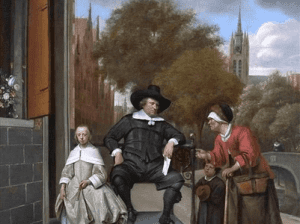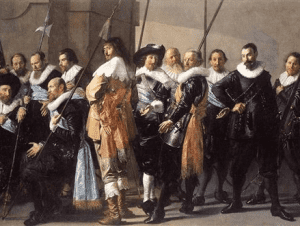The Aesthetic Movement Simplified
The Aesthetic Movement wanted to escape the hideousness and materialism of the industrial era by concentrating on creating beautiful art rather than having a more profound purpose – ‘art for the sake of art.’ Beauty has as much significance as man has emotions. Beauty is the symbolic emblem of symbols.
Summary of The Aesthetic Movement
The daring, sensual aesthetic trend in the mid-19th century threatened the dismantling of the fussy, overwhelming and rigid Victorian customs. Aestheticism permeated many aspects of life – from music, literature to interior design and fashion, more than just a high art movement. At the core of this project was a desire to produce “art for art’s sake” and elevate taste, beauty and self-expression above moral demands and rigid compliance. The freedom of artistic expression and sensuality encouraged by aesthetics delighted their supporters, but made them a mockery among the Conservative Victors. Nonetheless, the aesthetic movement helped set the scene for global, 20th century contemporary art by eschewing previously didactic responsibilities and concentrating on self-expression.
Rebellion against the victorian materiality and contemporary industrialism (especially the impoverished and repetitive design that “soulless” machinery has produced for consumers), aesthetic artists put an emphasis on excellent workmanship in creating various kinds of art. Some have even resurrected pre-industrial methods.
Esthetic artists have proclaimed art for the sake of art, separating art from the conventional duty to transmit a moral or socio-political message. They concentrated instead on exploring colour, shape and composition in search of beauty.
Aesthetics is defined by muted hues, geometric design and simple linear forms which are distinct from the Victorian penchant for the fussy design, curvy shapes and rich details. Pre-Raphaelite paintings with blazing red haired beauty, mediaeval geometric design and Japanese themes and aesthetics were the main sources of inspiration of the movement.
The Esthetic Movement believed that art must be an integral element of the daily life, not limited to painting, sculpture, and architecture. For this purpose, estheticism included not just high-end art, but also pottery, metalwork, fashion, furniture and interior design. Many aesthetics, like Oscar Wilde, even embraced prominent individuals by whom they lived according to aesthetic ideals.
Everything About The Aesthetic Movement
The Beginnings
The 1851 Great Exhibition represented a turning point in Britain’s visual arts. While the event highlighted significant recent advances, notably the new medium of photography, many of the exhibition works adhere to the Victorian style of fussy and shallow design. Worse still, the automation of the creative process was dehumanising design according to renowned critic John Ruskin. The predictable and repetitive designs combined with the stringent Victorian art standards which put more emphasis on the moral message than quality of the piece promoted a suffocating atmosphere that many artists desperately escaped.
Shortly after the end of the Grand Exhibition, a group of painters created a new and more basic aesthetic – one influenced by the complex details and hues of mediaeval art and design. By the 1860s, the work of the so-called Pre-Raphaelite Brotherhood became famous because of John Ruskin’s positive evaluations. The group then broke up with young painters such as William Morris and Edward Burne-Jones to establish a culture of “Cult of Beauty,” that lays the basis of aestheticism with Dante Gabriel Rossetti. Rossetti’s sensuous pictures of unconventionally beautiful, wide-eyed and red-haired ladies, decorated in loose, flowing robes, established a new ideal for women’s beauty that contested Victorian links between non-corsed women with red hairs and sexual licentiousness.
When Japan officially started dealing with Western countries in 1854, its goods swamped the British market. The stylised organic motives, circular shapes and geometric patterns that defined this new style have attracted artists and customers alike. Its elegant shape and simplicity contrasted starkly with cluttered and chaotic Victorian styles. British customers started to acquire Japanese screens, fans, porcelain and stains, imitating Japanese lacquer, with their ebony of furniture. Painters like James Abbott McNeill Whistler started to include these objects into his work, while changing their compositions in order to represent the original aesthetic. E.W. Godwin and Christopher Dresser were also influenced by designers. Within the aesthetic movement, a new style gradually developed called the Anglo-Japanese.
Like its pre-Raphaelite, aesthetic painters attach considerable emphasis to the visual composition of a piece. But whereas pre-Raphaelite painting had nearly always narrative substance, aesthetic painters usually eschewed a clear tale or message. Instead they are trying to create a mood, investigate colour harmony, or rediscover the complex nuances associated with excellent manufacturing. Drawing from many influences such as Ancient Greek, Japanese and Medieval Art, they aggressively promoted their slogan, ‘Art for the sake of art,’ borrowed from the book Mademoiselle de Maupin by French critic and poet Theophile Gautier (1836). This contemporary idea that art should be judged according to its own standards instead of the importance of the topic or true representation became a call for artists who are keen to distinguish art from Victorian materialism. When Walter Pater argued for the importance of the aesthetic experience of art in the history of the renaissance, he was one of the major voices of the Esthetic movement (1873). Pater says, Pater, “The poetic emotion, the desire for beauty, the love of art for its own reason, contains much of this knowledge. For art comes to you and honestly suggests that you offer just the greatest quality of your moments, only for those reasons.”
When Grosvenor Gallery on Bond Street opened in 1877, painters, particularly aesthetic artists, exhibited works which contradicted the traditional standards of the Royal Academy. It boosted the careers of James Abbott McNeill Whistler, Albert Moore, George Frederic Watts and Edward Burne-Jones in particular. Not only did the Gallery Grosvenor become the first to use electric lighting, but also established a novel exhibition technique (today the usual way for galleries and museums) in which paintings are placed with sufficient space to enable the spectator to absorb, as Walter Pater describes. In a private home, the exhibition area was designed to represent the gallery, and was flanked by other sumptuously furnished rooms which complied with the aesthetic design standards. Adornments featured ionic columns with golden capitals, verde-genoan marble, broad escalators and green and yellow silk damask, and moved to be ridiculed as Gilbert and Sullivan’s comedic opera, the Greenery Gallery of Grosvenor Gallery.
The distinguished critic John Ruskin appreciated the creative expression of pre-Raphaelites and acceded to the fact that design standards for machine-produced ornamental arts had so greatly deteriorated that their soul and workmanship was missing. He also supported, however, the social usefulness of art, which conflicts directly with the “art for art’s sake” attitude of the aesthetic movement. For Ruskin, art was not only about taste but also about intelligence, emotion, morality and knowledge. Ruskin wrote a critical critique of Later’s Nocturne in Black and Gold: The Falling Rocket when the Gallery of the Grosvenor opened in 1877 with an exhibition of art by Burne-Jones and Whistler (1874). In opposition to what he saw was meaninglessly produced content, Ruskin said, “I have seen, and heard, much of cockney impudence before now; but never expected a coxcomb to ask two hundred guineas for flinging a pot of paint in the public’s face…” Whistler launched a libel lawsuit against Ruskin the next year and while the artist’s victory was only harmful, the critical career of Ruskin that was never completely recovered was damaging. Ruskin, who had raised the career of many Pre-Raphaelite artists in the 1850s, was now out of sync with the contemporary trend of art.
Concepts in The Aesthetic Movement
Inspired by the sensuous feminine portraits of Rossetti, aestheticism initially appeared in paintings. The movement and its ideals have seeped into various areas via this medium. Of all the artists of aesthetics, artists were probably most prepared to achieve the objective of the movement to create art for the sake of art. This is because, unlike fashion and ornamental arts, paintings may be readily divorced from practical purposes. Thus artists like as Moore, Whistler, and Leighton could concentrate completely on producing beautiful and sensuous compositions. As oil paints make delicate tonal shifts possible, aesthetic artists may utilise the medium to investigate colour harmonies and tonal variation. Many of these painters, especially Whistler, also included in their work Japanese designs (peacocks, fans, vases) and aesthetics (such as brushwork of feather or simplified shapes).
Although some Victorian musicians, most remarkable Eduard Hanslick, defended formalism and a separation of music from any duty to convey anything beyond themselves, there seemed to be no aesthetic musicians in particular. However for many aesthetic artists, the medium was a significant source of inspiration. In the 1870’s, the critic Walter Pater famously affirmed that “all the arts aspire to the condition of music.” This was the centre of aesthetic artists, who thought music might imitate a perfect art form. In this procedure narrative information was eradicated in order to create an impression or evocation by the “harmony” of colours and arrangement. Painters like Whistler and Frederick Leighton have even named their works in the style of music. Whistler emphasised the link between art and music and the function of the artist as creator: “Nature holds the components of all photos in colour and shape, as the keyboard contains all the music notes. But the artist was created to choose and arrange these components, along with science, so that the outcome might be beautiful – when the musician collects his notes and shapes his chords till he produces the magnificent harmony of chaos.”
Houses and studios built by and supervised by Aesthetes diverged from traditional academic tradition by bringing together apparently unrelated inspiration sources to produce a distinctive design. Frederic Leighton’s House, for example, had allusions to the Orient, the Middle East and the Italian Renaissance. Instead of a typical British lobby or tea room, visitors enter what is referred to as the “Arab Hall,” an intricately designed dome space that combines many distinct aspects of Middle East architecture. Whistler meantime created the renowned Peacock room for Frederic Leyland, a shipping tycoon inspired by a lacquer box in Japan. Often these eclectic houses required cooperation between industrial artists, such as William Morris and Charles Voysey. The beauty of the building as a reflection of its multifaceted occupants surpassed conformity to a single style for aesthetic architects and designers.
For the first time, the Esthetic movement saw designers acknowledged and even praised for their outstanding workmanship. Designers were seldom acknowledged before estheticism. Thanks in part to William Morris, a designer-poet-socialist, design as a profession acquired credibility as an art form. Christopher Dresser, Edward Godwin and William Morris were famous designers of the period. These artists have produced geometrical, stylized furniture, metals, textiles and ceramics influenced by mediaeval and Japanese aesthetics and themes of floral, plant and zoomorphic styles. These designs provided clean lines and simplicity of shape which was meant to counteract most Victorian goods. Some designers, such as Morris, set up their own brand. Others, like Walter Crane and Christopher Dresser, worked together with retailers and manufacturers to produce medium-sized household goods. Thanks to the idea of Oscar Wilde “the house beautiful,” which claimed that the inside of a house should be as attractive as possible with the goal of giving its residents with an inspiring atmosphere, aesthetic stores selling these goods flourished. The most renowned were Arthur Liberty’s from London, which opened in 1875 and offered fabrics from the Middle East and Japan as well as specifically created consumer items in aesthetic style.
By the 1890s, aesthetic stores began selling consumer goods to satisfy the desire of the people to play an aesthetic role. This meant dressing the piece for some. Women have abandoned tight corsets and heavy materials to reflect the gracious beauty seen in Rossetti’s pre-Raphaelite paintings, for loose, unstructuring clothing adorned with beautiful floral broding. Some even increased the colour of their hair using henna. The males wore the role of the Foppish dandy, preferring velvet coats, flying ties and panties, inspired by the flamboyant male peacock (a prominent symbol of the Esthetic movement). The quintessential dandy, the playwright and writer Oscar Wilde, became the most closely linked emblem of celebration. Wilde, like many other artistic men, was criticised for its sense of fashion. For example, when he participated in the inauguration of the Grosvenor Gallery with a flashy costume that looks like a cello, he was much criticised.
As in the visual arts, aesthetic literature is a formal beauty topped by a social or moral message. Inspired by the late 1860s writings by Walter Pater, aesthetic authors, particularly by Oscar Wilde and Algernon Charles Swinburne, produced poetry and proses that were sensual and full of suggestions rather than clear explanations. Aesthetic poetry and authors, including Gilbert and Sullivan as well as Punch Magazine editors, were despised and satirised by their Victorian contemporaries.
The End of The Aesthetic Movement
The public triumph of aesthetics appeared guaranteed by the President of the Royal Academy in 1878, the aesthetic painter Frederic Leighton. Leighton made it his task to guarantee that non-academic paintings were equally taken into account and exhibited publicly at their annual spring showcase. He has appointed other aesthetic painters to be elected to the Academy, notably Albert Moore and Edward Burne-Jones.
Although aesthetics have been popular with many individuals, they have also become ridiculous. In 1881, Gilbert and Sullivan written the comedic opera “Patience” which ridiculed Aesthetes and their ideals, while George du Maurier created a renowned cartoon depicting a fashionable “aesthetic” couple who were worried whether they could live up to their precious teapot.
The lack of one clear, coherent movement concept meant that certain artists drifted in various ways. Socialist William Morris, for instance, lamented “ministering to the swinish luxury of the rich” and tried not only progressive aristocracy but to make his work accessible to the people. His views gained momentum and Morris became a prominent advocate for the movement of arts and crafts. In Britain, his participation encouraged designers to rediscover pre-industrial methods in order to differentiate their craft from machinery. The Bauhaus movement reconciled what Morris could not do in Germany, where distance from modern technology was not as prevalent. They blended aesthetic concepts of craft and design with contemporary technology to create excellent designs for home goods and furniture in particular.
Still more Esthetes, like Oscar Wilde and Aubrey Beardsley, deepened their self-sufficiency into startling victorian society. Their efforts developed into the Decadent movement that soon became popular when combined with immorality and sexual promotions, due in part to the trial of Oscar Wilde and the incarceration of people for “gross indecency”
While public awareness of Wilde’s participation in the aesthetic movement meant that it also suffered, the contemporary concept of ‘art for the sake of art’ confirmed the position of the movement in art history. The notion that art had its own inherent worth freed art from a moral or historical significance duty. For contemporary artists, this rejection of the past (of historical or mythical narration) became essential. In terms of the topic choice and aesthetic depiction, the artist was believed to enjoy freedom of expression. In conjunction with a desire to study the formal aspects of painting (colour, forms and composition), this concept of self-expression culminated in the mid-20th century Abstract Expressionist movement and continues to form a basis for the creative exploration of many contemporary artists in the 21st century.
Key Art in The Aesthetic Movement
Nocturne: Blue and Gold – Old Battersea Bridge
1872-1875

This book shows a night picture of the Thames Bridge in London. The bridge was constructed of wood and was replaced with a contemporary bridge. The scene is painted at dawn, with nebula on the river, hazy building luminaires from afar and fireworks in the sky beyond. The impression is calm and beautiful, hiding the filth of the river and the loud realities of metropolitan life. Instead, Whistler was unconcerned with producing a real image, instead on causing an emotional reaction in the spectator via a calming colour palette, smooth brushwork and harmony in shapes.
The Golden Stairs
By Edward Burne-Jones
1880

Built for the Grosvenor Gallery in 1880, The Golden Stairs is the picture by Burne-Jones that most nearly matches the goals of the aesthetic movement. Although many of the paintings by the artist include narrative material and moral themes, he does away with it in The Golden Stairs to create a composition focused solely on aesthetics. Each woman going down the golden stairwell, wearing a similarly classic robe, is proportional to being tall and thin and resonates with the form of the picture. The characters’ clothes are slightly varied, offering ornamental detail, which does not overwhelm the viewer’s sight. Each has a distinct musical instrument as they descend the stairs described as visual references to musical scales. Without a doubt, a reference to the famous claim of Walter Pater that “all the arts aspire to the condition of music,” was music on stairs, the original title of the picture.
Charger
By William de Morgan
1888

This big plate has an exquisite, fully plumed peacock. The arc of the feathers of the paon mimics the curve of the plate. The bright exhibition of the pavement against a more muted but no less complex vegetative pattern provides a cohesive and well adjusted structure. The male peacock was a major motive in the movement of aesthetics. In a more festive manner, Male Aesthetes donned clothing as sophisticated as their female counterparts, remembering the showy masculine pact whose tail plumes therefore became symbols for the expressive appearances of Aesthetes.
The Bath of Psyche
By Lord Frederic Leighton
1889-1890

Frederic Leighton, a lover of classical art, portrays the famous legends Psyche and Cupid, choosing a position that reflects the old Greek sculpture Venus Callipyge (made as early as 300 BCE). Before her bath, the person seems to be undressing, fascinated by her own reflection in the water below. The connection of Psyche and reflections reflects the estheticism’s visual focus and, in particular, its love of ideal beauty.
Information Citations
En.wikipedia.org, https://en.wikipedia.org/.
Recommend0 recommendationsPublished in Art Movements







Responses